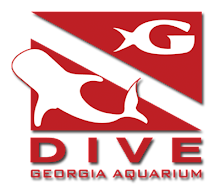 Recently, surface supply training classes were held for volunteers and staff, as surface supply is used in most of the tanks. The advantage to surface supply is the absence of a large tank which would hinder movement in exhibits and small areas where work may be necessary. Each class lasted two days, consisting of both classroom work along with actual surface supply diving to practice the skills taught.
Recently, surface supply training classes were held for volunteers and staff, as surface supply is used in most of the tanks. The advantage to surface supply is the absence of a large tank which would hinder movement in exhibits and small areas where work may be necessary. Each class lasted two days, consisting of both classroom work along with actual surface supply diving to practice the skills taught.Surface supply diving is diving while supplied air from the surface: in this case, two tanks are hooked up to an air cart which supplies the
 compressed air down to the divers through an umbilical. The umbilical consists of both the air supply tube along with a communications connection. The communications connection runs from a communications box at the surface and connects to the full face mask of the diver underwater. With this, divers can speak to the tenders at the surface, and vise versa. Surface supply also has the advantage of allowing for longer bottom times as a diver does not have to come up to switch out tanks. Instead, the tender at the surface does this, providing a continuous air supply for whatever length of time the dive lasts. Though a large tank is not attached to the diver, there is a backup air supply in the form of a pony bottle, a small tank that will supply enough breathing gas to safetly get to the surface in case of umbilical failure.
compressed air down to the divers through an umbilical. The umbilical consists of both the air supply tube along with a communications connection. The communications connection runs from a communications box at the surface and connects to the full face mask of the diver underwater. With this, divers can speak to the tenders at the surface, and vise versa. Surface supply also has the advantage of allowing for longer bottom times as a diver does not have to come up to switch out tanks. Instead, the tender at the surface does this, providing a continuous air supply for whatever length of time the dive lasts. Though a large tank is not attached to the diver, there is a backup air supply in the form of a pony bottle, a small tank that will supply enough breathing gas to safetly get to the surface in case of umbilical failure. 
Jeff Reid explained the importance of using the correct coiling techniques.

Surface supply diving is very unique and has a very different feel to it than scuba diving, as one is not burdened with a main air supply cylinder on his or her back.


No comments:
Post a Comment